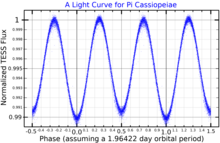

Pi Cassiopeiae, Latinized from π Cassiopeiae, is a close binary star[8] system in the constellation Cassiopeia. It is visible to the naked eye with an apparent visual magnitude of +4.949.[2] Based upon an annual parallax shift of 18.63 mas as seen from Earth,[1] this system is located about 175 light years from the Sun.

This is a double-lined spectroscopic binary system with an orbital period of nearly two days in a circular orbit.[8] It is classified as a rotating ellipsoidal variable star and its brightness varies by 0.02 magnitudes with a period of 23.57 hours,[5] which equals half of its orbital period. The spectrum matches that of an A-type main-sequence star with a stellar classification of A5 V.[3] The two stars have similar masses and spectra.[4] A star at a projected separation of 1,700 AU has been identified as a possible white dwarf. It is at the same distance as Pi Cassiopeiae and shares a common proper motion. The age of the white dwarf is calculated to be about 500 million years.[14]
Pi Cassiopeiae has been given the spectral class of kA3hF1mA5, indicating an Am star,[15] but this is now considered doubtful.[16]
|
| |||||||||||||
|---|---|---|---|---|---|---|---|---|---|---|---|---|---|
| |||||||||||||
| Stars |
| ||||||||||||
| |||||||||||||
| |||||||||||||
| Nebulae |
| ||||||||||||
| Galaxies |
| ||||||||||||
| |||||||||||||